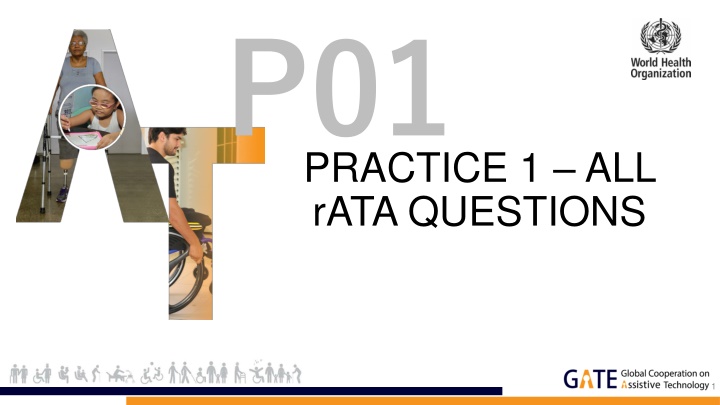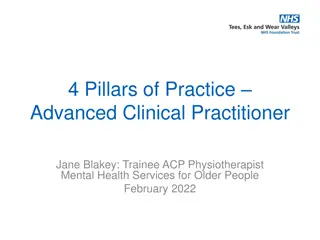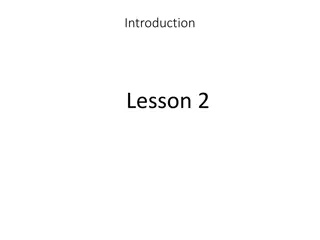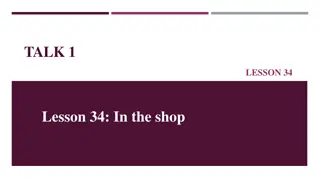Lesson on rATA Practice with Case Studies and Questions
This lesson involves practicing rATA (Assistive Technology Assessment) with case studies of individuals like Nina and Arlene. Participants will analyze their needs, challenges, and potential solutions through structured questions and role-play interviews. The session covers understanding individual complexities, AT use, skip logics, and the overall rATA structure. The goal is to enhance competencies in assessing assistive technology requirements effectively.
Download Presentation

Please find below an Image/Link to download the presentation.
The content on the website is provided AS IS for your information and personal use only. It may not be sold, licensed, or shared on other websites without obtaining consent from the author.If you encounter any issues during the download, it is possible that the publisher has removed the file from their server.
You are allowed to download the files provided on this website for personal or commercial use, subject to the condition that they are used lawfully. All files are the property of their respective owners.
The content on the website is provided AS IS for your information and personal use only. It may not be sold, licensed, or shared on other websites without obtaining consent from the author.
E N D
Presentation Transcript
PRACTICE 1 ALL rATA QUESTIONS 1
Lesson outcomes: PRACTICE 01 After this lesson, you will: FUNCTIONS >Up to 90 minutes Competencies and behaviours >Overall modules >A first look at the individual questions Understands potential challenges >Complex AT use >Complex skip logics Links to rATA manual >ALL EXPERIENCE ALL MAIN rATA Lesson time Knows the rATA structure 2
Lesson briefing for practice 01 Your self-directed activity Feedback session Case study 0 Case study 1 Case study 2 Review of Structured questions Role-play interview Role-play interview Role-play interview Reflection on training Structured questions Structured questions Structured questions Keep notes on these questions Follow-up for Q&A, whole-group feedback Extension (if time permits / homework) 3
P.0a Practice rATA with case study 0 Nina You are conducting a survey in Kenya. Nina (female) is a 34 year old dentist. She is married, but has no children. 15-20 minutes Read the case study carefully Nina: Does not experience any difficulties with any functions. She says she has quite a few aches and pains after she exercises, but these don t affect her that much. In small groups (if relevant) go through the rATA questions for Nina. Allocate 1 person to answer for Arlene Move forward when you have carefully reviewed and discussed the case She does not use any AP As a dentist, she asks you if dentures (false teeth) are an assistive product. 4
P.0a Practice rATA with case study 0 Nina Answer the following questions be prepared to report back after the practice session Do you think Nina is a typical person you will survey? Why/why not? How long do you think a survey like this should take? How do you think you should address Nina s comment about maybe will need glasses in the future ? Move forward when you have carefully reviewed and discussed the case 5
P.1a Practice rATA with case study 1 Arlene Arlene lives in a peri-urban area of Mindanao in the Philippines. She is 75, and over the last 5 years found it harder to remember basic things like medication. She finds it difficult to live by herself, because she doesn t feel safe cooking, and her hands are not strong. She is able to bathe and toilet by herself, but her family is worried about her. Three teenage grandchildren live nearby, and take turns to help, but are busy at school. Her own children work full time in a family-run tyre repair shop. ~30 minutes Read the case study carefully A community aged-care worker makes some suggestions about changing how Arlene eats and cooks, and links her with some extra community support. The worker helped get some assistive products including a box for medication, a waterproof chair for her shower, and some new glasses to replace a 10 year old prescription which were too weak. In small groups (if relevant) go through the rATA questions for Arlene. Allocate 1 person to answer for Arlene Move forward when you have carefully reviewed and discussed the case 6
P.1b Practice rATA with case study 1 Arlene How might Arlene answer part C functioning questions? How do functioning questions affect skip logic? Which products does Arlene use? Which products do you expect Arlene might need? Move forward when you have listed answers for all of these questions Answer the following questions be prepared to report back after the practice session 7
P.1c Practice rATA with case study 2 Darit Darit was born 3 weeks ago, and his parents noticed his hip seemed to be quite stiff, and seems to be causing him pain. Information: Darit has a condition known as congenital or developmental dysplasia of the hip. It means his hip joint did not form as expected, which can create difficulties and pain. Many people who have this condition in infancy have early onset arthritis. A common form of treatment is a type of harness worn by babies, that helps hold the hip in place while muscles strengthen. Go through rATA questions for Darit Read the case study carefully In small groups (if relevant) go through the rATA questions for Arlene. Allocate 1 person to answer for Arlene 8
P.1d Practice rATA with case study 2 Darit Is Darit eligible for the survey? What are implications of proxy interviews? What product/s would Darit s caregiver select for USE? What might happen in the NEED section? What might cause satisfaction/dissatisfaction with this product? Answer the following questions be prepared to report back after the practice session 9
P.1e Knowledge check How does the survey change for different people: Age, function, use of products, need, other What are the different ways to ask a question & enter answers Read/do not read options aloud Select all that apply Select one Enter text Drop down boxes List the main rATA features for: Someone with no difficulties, needs or use of AT proxy interviews Someone who uses many products Reflect on these questions Any questions that are difficult can be raised in Q&A sessions 10
P.1f Extension What barriers did you discuss? Discuss each option: are they likely/unlikely? What type of people might answer the different options? What likely sources were discussed? Discuss the different sources: Which are most likely/unlikely Who might access products from the different sources? Discuss costs: Discuss some reasons costs might be difficult to estimate? What might be some ways to help answer costs questions CONTINUE the activity with additional case studies Further questions for discussion and question & answer session (if you have time) 11























